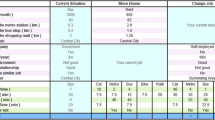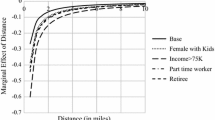Abstract
This paper examines the location choice associated with discretionary activities (in-home vs. out-of-home). These substitution patterns are important in terms of travel demand as in-home activities do not necessitate travel while out-of-home activities incur travel. Mixed logit models are estimated using an activity dataset (2003 CHASE data) to analyze the factors associated with this choice at the individual activity-level. Results suggest that the attributes of an activity significantly contribute to understanding the likelihood of engaging in out-of-home activities. Activity type interaction terms reveal the varying influence that socio-demographics, activity attributes and travel have over four different activity types modeled. The results reveal that the location choice (in-home vs. out-of-home) is sensitive to travel characteristics. As the travel time and cost increases, an individual is less likely to engage in an activity out-of-home. Compared to passive and social activities, the location of active activities is more sensitive to changes in travel attributes.
Similar content being viewed by others
References
Akar, G., Clifton, J.K., Doherty, S.T.: Discretionary Activity Location Choice: An Examination of Temporal Dimensions and Activity Attributes of In-Home or Out-of-Home Location Choice. World Conference on Transportation Research (WCTR), UC-Berkeley (2007)
Bastin, F., Cirillo, C., Toint, P.L.: Application of an adaptive Monte Carlo algorithm to mixed logit estimation. Transp. Res. Part B 40(7), 577–593 (2006)
Bhat, C., Lockwood, A.: On distinguishing between physically active and physically passive episodes and between travel and activity episodes: an analysis of weekend recreational participation in the San Francisco Bay area. Transp. Res. Part A Policy Pract. 38(8), 573 (2004)
Bhat, C.R., Gossen, R.: A mixed multinomial logit model analysis of weekend recreational episode type choice. Transp. Res. Part B Methodol. 38(9), 767 (2004)
Bhat, C.R., Koppelman, F.S.: A retrospective and prospective survey of time-use research. Transportation 26, 119–139 (1999)
Bhat, C.R., Misra, R.: Discretionary activity time allocation of individuals between in-home and out-of-home and between weekdays and weekends. Transportation 26, 193–209 (1999)
Bhat, C.R., Srinivasan, S., Sen, S.: A joint model for the perfect and imperfect substitute goods case: application to activity time-use decisions. Transp. Res. Part B Methodol. 40(10), 827–850 (2006)
Bowman, J.L., Ben-Akiva, M.E.: Activity-based disaggregate travel demand model system with activity schedules. Transp. Res. Part A. Policy Pract. 35(1), 1–28 (2001)
Cirillo, C., Axhausen, K.W.: Evidence on the distribution of values of travel time savings from a six-week diary. Transp. Res. Part A 40, 444–457 (2006)
Cirillo, C., Axhausen, K.: Dynamic model of activity-type choice and scheduling. Transportation. doi: 10.1007/s11116-009-9218-8, available at http://www.springerlink.com/content/55j422640140424u (2009)
Cirillo, C., Toint, P.L.: One Activity-Based Framework for Europe. ETC. European Transport Conference, Cambridge, UK (2002)
Doherty, S.T.: Should we abandon activity type analysis? Redefining activities by their salient attributes. Transportation 33(6), 517–536 (2006)
Doherty, S.T., Miller, E.J., Axhausen, K.W., Gärling, T.: A conceptual model of the weekly household activity-travel scheduling process. In: Stern, E., Salomon, I., Bovy, P. (eds.) Travel Behaviour: Patterns, Implications and Modelling (2002)
Doherty, S.T., Nemeth, E., Roorda, M., Miller, E.J.: Design and assessment of the Toronto area computerized household activity scheduling survey. J. Transp. Res. Board 1894, 140–149 (2004)
Ettema, D., Timmermans, H.J.P.: Theories and models of activity patterns. In: Dick, E., Timmermans, H.J.P. (eds.) Activity-Based Approaches to Travel Analysis. Pergamon, Oxford, UK, pp. 1–36 (1997)
Golob, T.F., McNally, M.G.: A model of activity participation and travel interactions between household heads. Transp. Res. Part B Methodol. 31(3), 177–194 (1997)
Greene, W.H.: Econometric analysis. Pearson Education Inc., India (2003)
Handy, S., Yantis, T.: The impacts of telecommunications technologies on nonwork travel behavior. SWUTC/97/721927–1F, Southwest Region University Transportation Center, Center for Transportation Research, The University of Texas at Austin (1997)
Kemperman, A., Arentze, T., Timmermans, H.: Social commitments and activity-travel scheduling decisions. Transp. Res. Rec. 1977(2006), 242–249 (2006)
Kitamura, R.: An evaluation of activity-based travel analysis. Transportation 15(1/2), 9–34 (1988)
Lu, X., Pas, E.I.: Socio-demographics, activity participation and travel behavior. Transp. Res. Part A (Policy and Practice) 33A(1), 1–18 (1999)
McFadden, D., Train, K.: Mixed multinomial logit models of discrete response. J. Appl. Econom. 15, 447–470 (2000)
McNally, M.G.: The activity-based Approach. Paper UCI-ITS-AS-WP-00-4, Institute of Transportation Studies Center for Activity Systems Analysis, University of California, Irvine (2000)
Miller, E.J., Roorda, M.J.: A prototype model of 24-hour household activity scheduling for the Toronto area. Transp. Res. Rec. 1831, 114–121 (2003)
Mokhtarian, P.L., Salomon, I.: How derived is the demand for travel? Some conceptual and measurement considerations. Transp. Res. A 35(8), 695–719 (2001)
Mokhtarian, P.L., Salomon, I.: Emerging travel patterns: do telecommunications make a difference?. In: Mahmassani, H.S. (ed.) In Perpetual Motion: Travel Behaviour Research Opportunities and Application Challenges. Pergamon Press/Elsevier, Oxford, UK, pp. 143–182 (2002)
Mokhtarian, P.L., Salomon, I., Handy, S.L.: The impacts of ICT on leisure activities and travel: a conceptual exploration. Transportation 33, 263–289 (2006)
Pas, E.I.: Recent advances in activity-based travel demand modeling. In: Activity-Based Travel Forecasting Conference, June 2–5, 1996: Summary, Recommendations and Compendium of Papers. New Orleans, LA, pp.79–102 (1997)
Pas, E.I., Harvey, A.S.: Time use research and travel demand analysis and modeling. In: Stopher, P., Gosselin, M.L. (eds.) Understanding Travel Behavior in an Era of Change. Elsevier Science Ltd., Oxford (1996)
Passmore, A., French, D.: Development and administration of a measure to assess adolescents’ participation in leisure activities. Adolescence 36(141), 67–75 (2001)
Redmond, L.S., Mokhtarian, P.L.: The positive utility of the commute: modeling ideal commute time and relative desired commute amount. Transportation 28(2), 179–205 (2001)
Reichman, S.: Travel adjustments and life styles: a behavioral approach. In: Stopher, P., Meyburg, A. (eds.) Behavioral Travel Models. Lexington Books, Lexington, Massachusetts (1976)
Roorda, M.J., Miller, E.J., Habib, K.: Validation of TASHA: a 24-hour activity scheduling microsimulation model. 86th Annual Meeting of the TRB (Transportation Research Board), Washington, DC (2006)
Train, K.: Discrete Choice Methods with Simulation, Cambridge University Press, Cambridge (2002)
Yamamoto, T., Kitamura, R.: An analysis of time allocation to in-home and out-of-home discretionary activities across working days and non-working days. 26, 211–230 (1999)
Acknowledgments
We greatly appreciate the funding support provided by the Social Sciences and Humanities Research Council of Canada for the collection of data used in this study.
Author information
Authors and Affiliations
Corresponding author
Rights and permissions
About this article
Cite this article
Akar, G., Clifton, K.J. & Doherty, S.T. Discretionary activity location choice: in-home or out-of-home?. Transportation 38, 101–122 (2011). https://doi.org/10.1007/s11116-010-9293-x
Published:
Issue Date:
DOI: https://doi.org/10.1007/s11116-010-9293-x




